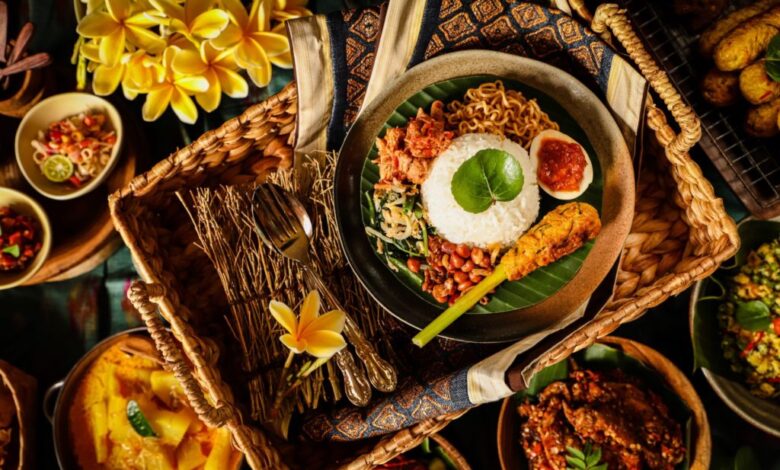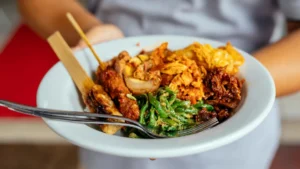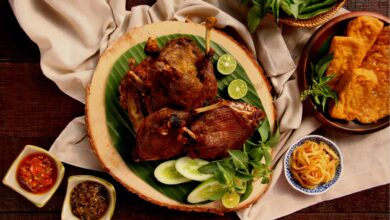Food and fruits in Bali

Food prices in Bali
Food prices in Bali are incredible. A dish in a simple tourist restaurant will cost 20,000-50,000 (twenty to fifty thousand Indonesian rupees – about $1.5-3 US dollars). At Warung, the same meal can cost just $1 or less. In simple warungs they sell so-called nasi bungkus (a pyramid-packed package of banana leaves containing 400 g of rice with a few tasty additions to take away) for only 3,000-5,000 rupees ($0.2-0.35). A universal option in warungs: Nasi Campur. This is rice (as a side dish) and several options for additives to choose from (meat or vegetables). The price of such a dish is 10,000-15,000 rupees (up to $1).
At the other end of the price scale there are plenty of truly fine world class restaurants. Of course, food prices in such places are higher. However, they are still affordable and not exorbitant. Seminyak is home to many of Bali’s trendy independent restaurants.
Ubud traditionally has the most interesting restaurants with healthy and healthy food (vegan, gluten-free, etc.). Many but the cheapest local restaurants typically add a 10% government sales tax and a 5% service charge to your bill. Sometimes the total surcharge on the bill is up to 21%. Some restaurants include this in the price, but take a closer look at the menu in advance to see if this is true or if you will have to pay extra.
An article about prices and money in Bali is here (not only about food but also other components of a vacation).
Balinese cuisine
Traditional Balinese cuisine is a distinct type of cuisine in Indonesia. It is common on the island, but not so much outside of Bali (due to its emphasis on pork, which is taboo for the majority of the Muslim population in the rest of the country). The most famous dishes you will encounter in Bali include:

Drinks in Bali
Drinks are good in Bali. From fresh avocado and watermelon juices to beer and alcohol. Here you will find it all in abundance. Regarding the latter, the Balinese have nothing against alcohol, provided that behavior remains decent.
Beer
Life is good for beer lovers in Bali. This is a popular classic light Asian beer that is sold absolutely everywhere on the island. You will also find other varieties here: Bali Hai, Storm, Anker, Carlsberg and San Miguel. Beer is relatively expensive locally, although still very cheap by Western standards (from 15,000 rupees – $1 per bottle).
Wine
Bali produces its own wines. Hatten is the oldest and most popular brand, available in white, red, rosé (the most popular) and sparkling varieties. Quality and taste are inconsistent, but the pink variety is generally ok. At the same time, it is much cheaper than imported wines, the cost of which can easily exceed 300,000 rupees per bottle ($22).
Arak and other Balinese alcohol
The traditional moonshine in Bali is Arak, a distilled spirit usually 40 proof. Sold in some stores and can be served in restaurants. There are known cases of selling low-quality products, which can lead to blindness and even death. Other traditional alcohol in Bali: Brem – rice wine, usually sold in beautiful clay bottles in souvenir shops. And finally, Tuak is a palm wine for traditional holidays.
Strong liquor
In Bali, strong alcohol is relatively expensive (high excise taxes and duties), but is still sold in almost many large stores. You can find traditional whiskey and vodka. Inexpensive options include white and Jamaican rum produced in Indonesia.
Drinking water
Tap water in Bali is not drinkable, but bottled water is widely available and inexpensive. The most popular brand is Aqua. Points of sale with filtered water are also widespread, ensuring tap water is purified to drinking level. Look for the name air putih. Water is quite cheap in these places, and the reusable containers used for it avoid the waste created by plastic bottles.
Juices
Juices in Bali are fresh, tasty and very cheap (from $1 for a large glass). They prepare both pure fruit juices and mixtures of them (this could be watermelon, melon, papaya, orange, lime, banana or almost any other fruit you can think of).

In Bali, avocado is used as a dessert fruit. Mixed with sugar (optional), a little water and ice – and sometimes chocolate syrup – it’s divine! If you don’t drink alcohol, Bali’s fresh juices in a variety of creative combinations will delight you endlessly. Almost all restaurant menus have a section dedicated to various non-alcoholic fruit drinks.
Coffee Luwak
There is “Balinese coffee” in Bali, but the most famous is Luwak coffee (Kopi Luwak), which is also called “cat poop coffee”. Its cost is high and in tourist places it can cost $15 per cup (in the places where it is made, in the interior of the island, it is much cheaper).
This coffee gets its name from the cat-like civet (luwak), which loves to feast on ripe coffee beans. Entrepreneurs collect intact beans found in the droppings of these animals and process them to produce Luwak coffee. The high popularity of the variety means that there are fakes, so take this coffee where it is made (at the same time you will get acquainted with the process and see the animal).
Bali for vegetarians and vegans
Bali is a vegetarian’s dream come true. The island has an abundance of fresh fruits, vegetables and spices. And many Balinese dishes are vegetarian or vegan, here are some of them: Nasi saur: rice seasoned with fried coconut, tofu, tempeh, vegetables. Urap: A delicious mixture of steamed vegetables with grated coconut and spices. Sayur hijau: green vegetable leaves (usually water yam) seasoned with chili and tomato sauce.
In addition, many popular dishes (the same Nasi Goreng, or Mee Goreng, described above) can be made vegan without any damage to taste. Just ask for no meat and instead include lettuce, tofu or tempeh. When ordering many dishes in a cafe, you can make a choice: meat or vegetarian.



